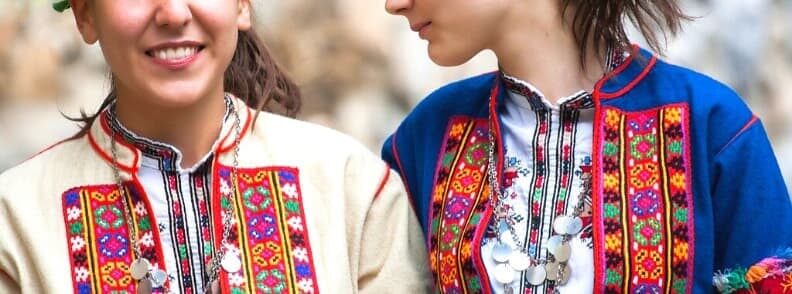Ancient local culture paved the way for festivals and traditions in Bulgaria that are still very much alive today. The country was the Slavic territory of Orpheus and Spartacus. Home to countless treasures, burial tombs, and exquisite art and frescoes reminiscent of centuries gone by, the Bulgarian state has an incredibly rich cultural heritage.
Through the festivals and traditions in Bulgaria, the locals still remember the days when men tried to appease the natural elements and trembled before their strength! Rich in beauty, cheerfulness, mysterious voices, fiery dances, and lively colored costumes, rural Bulgarian folklore must be seen, heard, and experienced!
Festivals in Bulgaria
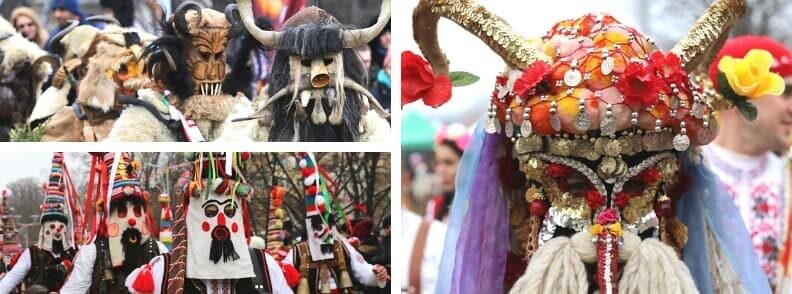
Kukeri Carnival
The Kukeri Carnival is held in the region of Dupnitsa and Pernik, during the scary Surva festival. It is among the festivals in Bulgaria that mark the beginning of Spring. With its brightly colored masks and costumes, this is a spectacular event presenting unique traditions in Bulgaria. Each participant makes his or her own multi-colored customized mask, lined with beads, ribbons, and woolen tassels.
The heavy swaying of the main dance represents wheat, thick with grains. The bells tied about the waist are intended to scare away bad spirits and illness.
The Rose Festival
The Rose Festival takes place at the foot of the Balkan Mountain Range, in the Rose Valley, near the town of Kazanluk. Celebrated on the first weekend of June, the festival is a show of beauty. Before this festival, the Queen Rose beauty contest takes place in several rounds. And, around the beginning of June, musicians, actors, circus performers, authors and singers flock together to Kazanluk to share traditions in Bulgaria with curious travelers.
The Rosa Damascena of Bulgaria yields 70% of the world’s roses, which are used as the main ingredient by perfume companies worldwide. So there’s no wonder that there are festivals in Bulgaria dedicated to this flower!
The story goes that in 1270, during the Crusades, the Damask Rose from Syria reached the Kazanlak valley, where the conditions proved excellent for its growth. Bulgarian roses and rose oil owe their special characteristics to the local climate and soil. The temperatures in February when roses bud, are ideal in the valley. And the flowers get picked in May and June when high humidity is very important.
Traditional music festivals in Bulgaria
The Pirin Sings and Rozhen Sings are the most popular folklore music festivals in Bulgaria. Spectators come from all over the world not only to listen to music but also to discover the fascinating traditions in Bulgaria.
Bulgarian voices are a complete mystery! To this day, experts are still trying to understand the amazing range of the Bulgarian voice and the quality of its songs. The unique sound was widely acknowledged by the fact that the famous Rhodope song Izlel e Delyu Hiadutin sung by Valya Balkanka, was recorded on a gold record and sent as a message to outer space on the American spaceship Voyager, in the year 1977.
The world is rediscovering this song and many others at big folklore and song competitions in Italy, France, England, and Ireland, at which Bulgarian music and dance ensembles usually win the first prizes.
Nestinari – Fire dancing or walking
Dances with barefoot performers on burning embers are the most common and enigmatic practice you’ll see at festivals in Bulgaria or even at restaurants when you’re taking part in a Bulgarian night. This religious and mystical ritual is meant to bring health and fruitfulness.
Other festivals in Bulgaria: The Veliko Tarnovo International Folklore Festival
Traditions in Bulgaria
Trifon Zarezan
On 14 February, the Bulgarians celebrate St Trifon Zarezan through one of the ancient holiday rites inherited from the Thracians. Dressed in their best Sunday, the vine growers prune the vines and sprinkle them with Bulgarian wine for a good harvest. Then, they all gather for a delicious meal.
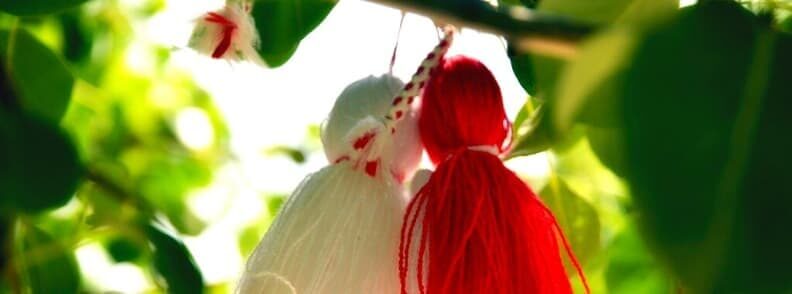
Martenitsa (or Martenitsi)
Every year, on 1 March, Bulgarians offer martenitsa to their relatives and friends, to bring them health and happiness. This is one of the pagan traditions in Bulgaria, and it symbolizes the end of the cold winter and the arrival of spring.
Martenitsa is to be worn until the person sees the first stork that year (though it’s a difficult task in the cities today). Then, they’re thrown into a tree. The red and white colors of the martenitsa reflect the snow and blood from a traditional tale in which a stork brings the blessing of a little child to the safety of its parents, who are far away. The arrival of the stork means that Spring has come.
This celebration is something you’ll find in several other Balkan countries, not just among the traditions in Bulgaria.
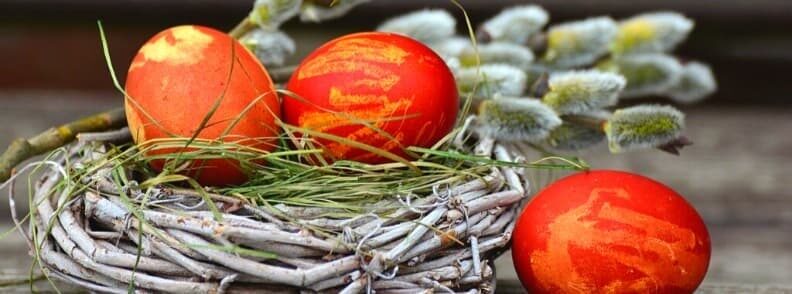
Easter in Bulgaria
Easter is among the Orthodox traditions in Bulgaria, symbolized through red eggs (Pasha). The eggs are colored on Holy Thursday, and nowadays several other colors are used besides red.
The eggs are cracked after the Saturday to Sunday midnight church service and in the following days. One egg gets cracked on the wall of the church, and for believers, it is the first egg to be eaten after a long time of fasting.
The rite of cracking the rest of the eggs takes place before the Easter Sunday lunch. According to traditions in Bulgaria, each person selects his or her egg. Then, Bulgarian people take turns tapping their eggs against the eggs of others, and the one who ends up with the last egg that has an intact shell will have a year of good luck.
Todorovden
On the occasion of Todorovden (St. Theodore’s Day), horse races take place all over the country. On the first Saturday of Lent, the Bulgarian folk has fun at the festival, also known as Horse Easter.
Races with horse rides and horse jumping are held according to old Bulgarian tradition. The men are expected to knit the manes and tails of their horses, then decorate them with tassels, beads, and flowers, according to tradition. Meanwhile, the women are responsible for kneading and distributing ceremonial bread made after old traditions in Bulgaria. They also use this ritual bread to feed the horses before the race. They also cook wheat, which is later blessed in the church.
In the past, the winner was given a towel or shirt, and the horse was given a new bridle. Nowadays, however, the prizes are often just money.
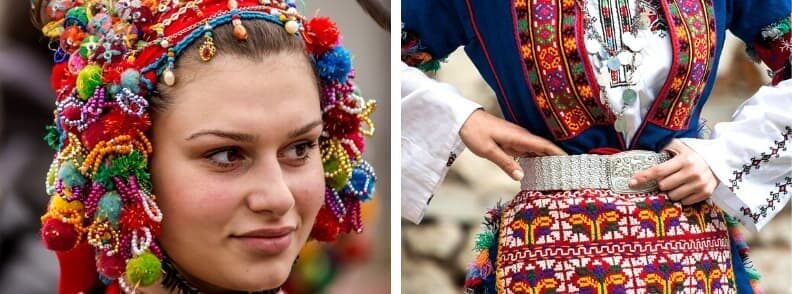
Traditional arts
Applied crafts have slowly evolved from home cottage industries to national arts. Bulgarian embroidery, with its intricate geometrical figures, rugs with vivid colors, painted ceramics, and exquisitely fashioned Bulgarian jewelry are just some of the traditional crafts.
The best places to discover traditions in Bulgaria are:
- Samovodene Bazar in Veliko Tarnovo
- Permanent National Folk Art Exhibition in Oreshak near Troyan
- Etura Architectural and Ethnographic Complex near Gabrovo
- The National Palace of Culture of Bulgaria is the largest multifunctional complex in South-Eastern Europe. Located in a beautiful park in the heart of Sofia, Bulgaria’s capital, it has a spectacular view of Vitosha Mountain in the distance. Inside, you can explore museums, plus historical and cultural sites of interest. There are also cafés, pubs, restaurants, nightclubs, and shops.
- Old Bulgarian villages where folklore traditions are kept alive and honored to this day.
You’re certain to find a Bulgarian souvenir here. A carved wooden wine decanter, a Troyan pottery set, a soft Rhodope rug, an original piece of silver jewelry, or a beautifully embroidered silk blouse are wonderful choices to take traditions in Bulgaria back home.

Mirela Letailleur is a Romanian travel blogger living in the South of France. She writes on The Travel Bunny travel blog about affordable travel in Europe, creator of unique free travel guides, local travel expert. Problem solver. Wannabe coffee guru.
Other travel articles you should read on The Travel Bunny blog
Travel tips for your trip to Bulgaria
Visit Bulgaria’s seaside cities (with map)
Balchik travel guide: Best things to do in Balchik, Bulgaria

